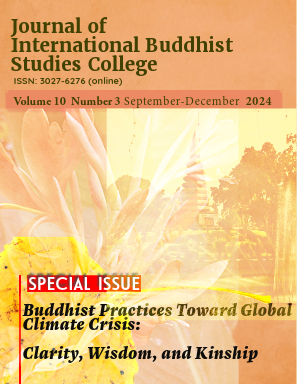Direct Realization of Ultimate Truth Through the No Method Path: A Practice for Women Without Abandoning Daily Activities According to Guru Padmasambhava
Main Article Content
Abstract
This article investigates the unique challenges faced by women in contemporary society through the lens of Buddhist teachings, particularly those of Guru Padmasambhava. It aims to (1) explore the obstacles women confront in modern life while seeking the path to ultimate truth, (2) delve into the no-method path as articulated by Guru Padmasambhava for realizing this truth, and (3) propose practical applications of this path that harmonize with daily activities. The research methodology includes a comprehensive analysis of sources such as the Tipiṭaka and its commentaries from the Pāli Text Society, various texts documenting Guru Padmasambhava's teachings, and relevant scholarly articles. Additionally, the study incorporates findings from interviews conducted with two groups: six Buddhist scholars and masters, and ten female practitioners aged 21 to 45 from the Hundred Flowers Meditation Retreat in Vietnam, all of whom have engaged with the no-method path for periods ranging from three to twelve months. Data obtained through individual and group interviews were analyzed using content analysis techniques.
The results indicate that contemporary women grapple with many societal misconceptions and erroneous perceptions that significantly influence their spiritual endeavors. An investigation into the two truths across diverse Buddhist traditions highlights the profound insights of Guru Padmasambhava. In the context of Theravāda Buddhism, the differentiations between conditioned phenomena—mind, mental factors, and form—and the unconditioned state of Nibbāna become apparent. In contrast, the doctrines of Mahāyāna and Vajrayāna articulate the ultimate truth as emptiness (śūnyatā), thereby underscoring its inseparable relationship with conventional truth.
Guru Padmasambhava clarifies that ultimate truth represents recognizing the true essence of mind and reality, transcending dualistic thought. This truth, perceived as the synthesis of emptiness and luminous clarity, unveils the inherent purity and perfection of all phenomena. His teachings contend that comprehending the intrinsically pure and luminous nature of the mind is essential for achieving liberation from the cycle of saṃsāra.
Importantly, the no-method path, frequently referenced within the Dzogchen and Mahamudra traditions, provides direct experiential wisdom that surpasses conceptual cognition. Female practitioners at the Hundred Flowers Meditation Retreat exemplify the practical application of these teachings by seamlessly integrating non-judgmental awareness into their everyday activities—be it through cooking, cleaning, or managing familial disputes. By fostering presence and relinquishing conceptual expectations, they embody the quintessence of Dzogchen, manifesting a pathway to self-liberation that aligns with the exigencies of modern life without necessitating the abandonment of worldly responsibilities.
Article Details
The Journal of TCI is licensed under a Creative Commons Attribution-NonCommercial-NoDerivatives 4.0 International (CC BY-NC-ND 4.0) licence unless otherwise stated. Please read our Policies page for more information on Open Access, copyright and permissions.
References
Boyd-Wilson, B. M., & Walkey, F. H. (2015). The enlightenment scale: Further evidence for validity. Journal of Transpersonal Psychology, 47(2), 121-136. https://doi.org/10.1179/ 2044024315Z.00000000046A
Buddhadāsa Bhikkhu. (2018). Nibbāna from every angle. Buddhadāsa Indapañño Archives.
Deshwal, D. (2021). Role of women in Buddhism: An analytical study. Research Inspiration, 6(IV), 01-03.
Deshwal, D. (2021). Role of women in Buddhism: An analytical study. Research Inspiration, 6(IV), 01-03.
Dhammarakkhita Bhikkhu. (2017). Vi dieu phap hien thuc trong cuoc song (Abhidhamma in practice in daily life). Hanoi: Ton Giao Publications.
Dorjee, D. (2013). Mind, brain and the path to happiness: A guide to Buddhist mind training and the neuroscience of meditation. Routledge. https://doi.org/10.4324/978131588 9580
Harding, S. (2010). Niguma, lady of illusion. Snow Lion Publication.
Harding, S. (2010). Niguma, Lady of Illusion. Snow Lion Publications.
Harvey, P. (2013). An introduction to Buddhism: Teachings, history and practices. Cambridge University Press.
Hsuan Hua. (2009). The Śūraṅgama Sūtra: A new translation. Buddhist Text Translation Society.
Hua, H. (2009). The Śūraṅgama Sūtra. Buddhist Text Translation Society.
Lama Chonam & S. Nyingpo (Trans.) (2011). The Guhyagarbha Tantra: Secret essence definitive nature just as it is. Snow Lion Publications.
Lim, H. L. (2021). Mindfulness and motivation in self-transformation: Thich Nhat Hanh’s teachings on the interbeing. International Journal of Dharma Studies, 9(1). https:// doi.org/10.1163/26659077-24030004
Loy, D. (2018). Ecodharma: Buddhist teachings for the ecological crisis. Wisdom Publications.
Nāgārjuna. (1995). Mūlamadhyamakakārikā: The fundamental wisdom of the middle way (J. L. Garfield, Trans.). Oxford University Press.
O'Leary, J. S. (2019). Reality Itself: Philosophical Challenges of Indian Mahāyāna. Chisokudo Publications.
Padmasambhava. (1989). Self-liberation through seeing with naked awareness. New York: Station Hill Press.
Padmasambhava. (1994). Advice from the lotus-born: A collection of Padmasambhava's advice to the Dakini Yeshe Tsogyal and other close disciples. Rangjung Yeshe Publications.
Padmasambhava. (2010). Self-liberation: Through seeing with naked awareness. Snow Lion Publications.
Sanders, C. (2019). Mindful motherhood: Buddhist practices for women balancing work, family, and spirituality. Routledge.
Sheehy, M. R. (2023). Cognitive illusion, lucid dreaming, and the psychology of metaphor in Tibetan Buddhist Dzogchen contemplative practices. International Journal of Transpersonal Studies, 42 (2). https://doi.org/10.24972/ijts.2023.42.2.63
Vien Minh, M. (2019). Awareness and Reality. Wisdom Publications.
Williams, P. (2009). Mahayana Buddhism: The doctrinal foundations. Routledge.


